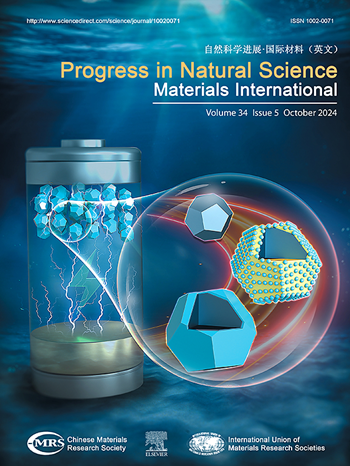一种设计新型高强塑性亚稳β钛合金的机器学习方法
IF 7.1
2区 材料科学
Q2 MATERIALS SCIENCE, MULTIDISCIPLINARY
Progress in Natural Science: Materials International
Pub Date : 2025-02-01
DOI:10.1016/j.pnsc.2024.11.010
引用次数: 0
摘要
为了提高效率和降低成本,建立了四种用于亚稳β钛合金设计的机器学习模型,包括Adaboost模型、LightGBM模型、Voting模型和Stacking模型。对这些模型的准确性进行了评估,所有模型在抗拉强度、屈服强度和伸长率方面都表现出优异的准确性。r²系数(R2)的值均大于0.9。其中,LightGBM模型精度最高,平均绝对误差(MAE)和均方根误差(RMSE)相对最小,R2相对最大。为了进一步验证模型的准确性,采用LightGBM模型设计了一种亚稳β钛合金Ti-5.5Cr-5Al-4Mo-3Nb-2Zr。三种热处理工艺下合金的抗拉强度、屈服强度和伸长率的预测值与实验值吻合较好。经850℃固溶0.5 h, 650℃时效8 h,合金的强度塑性匹配最佳,抗拉强度为1317 MPa,伸长率为11.17%,强度塑性产物为14.711 GPa·%。本文章由计算机程序翻译,如有差异,请以英文原文为准。
A machine learning method approach for designing novel high strength and plasticity metastable β titanium alloys
In order to improve efficiency and reduce costs, four machine learning models were established for the design of metastable β titanium alloys, including the Adaboost model, the LightGBM model, the Voting model, and the Stacking model. The accuracy of these models was evaluated, and all models exhibited excellent accuracy for tensile strength, yield strength, and elongation. The values of R-squared coefficients(R2) all greater than 0.9. Among them, the LightGBM model showed the highest accuracy, with relatively smallest values of mean absolute error (MAE) and root mean square error (RMSE) and relatively largest value of R2. To further verify the accuracy of the model, a metastable β titanium alloy Ti-5.5Cr-5Al-4Mo-3Nb-2Zr was designed by the LightGBM model. The predicted values of the alloy's tensile strength, yield strength, and elongation under three heat treatment processes were in high agreement with the experimental values. The alloy exhibited optimal strength-plasticity matching after undergoing a solution treatment at 850 °C for 0.5 h, followed by aging at 650 °C for 8 h, with a tensile strength of 1317 MPa, an elongation of 11.17 %, and a strength-plasticity product of 14.711 GPa·%.
求助全文
通过发布文献求助,成功后即可免费获取论文全文。
去求助
来源期刊
CiteScore
8.60
自引率
2.10%
发文量
2812
审稿时长
49 days
期刊介绍:
Progress in Natural Science: Materials International provides scientists and engineers throughout the world with a central vehicle for the exchange and dissemination of basic theoretical studies and applied research of advanced materials. The emphasis is placed on original research, both analytical and experimental, which is of permanent interest to engineers and scientists, covering all aspects of new materials and technologies, such as, energy and environmental materials; advanced structural materials; advanced transportation materials, functional and electronic materials; nano-scale and amorphous materials; health and biological materials; materials modeling and simulation; materials characterization; and so on. The latest research achievements and innovative papers in basic theoretical studies and applied research of material science will be carefully selected and promptly reported. Thus, the aim of this Journal is to serve the global materials science and technology community with the latest research findings.
As a service to readers, an international bibliography of recent publications in advanced materials is published bimonthly.

 求助内容:
求助内容: 应助结果提醒方式:
应助结果提醒方式:


